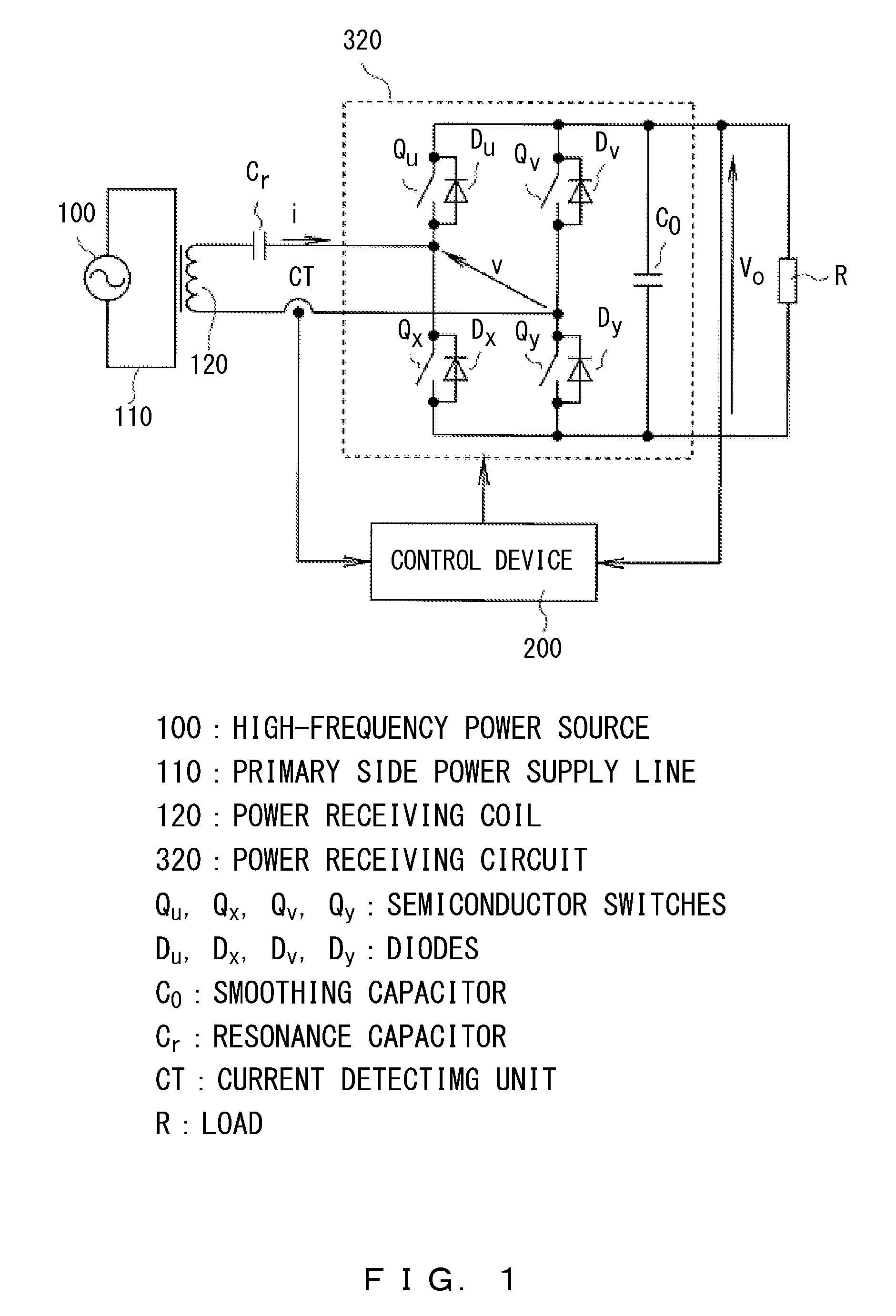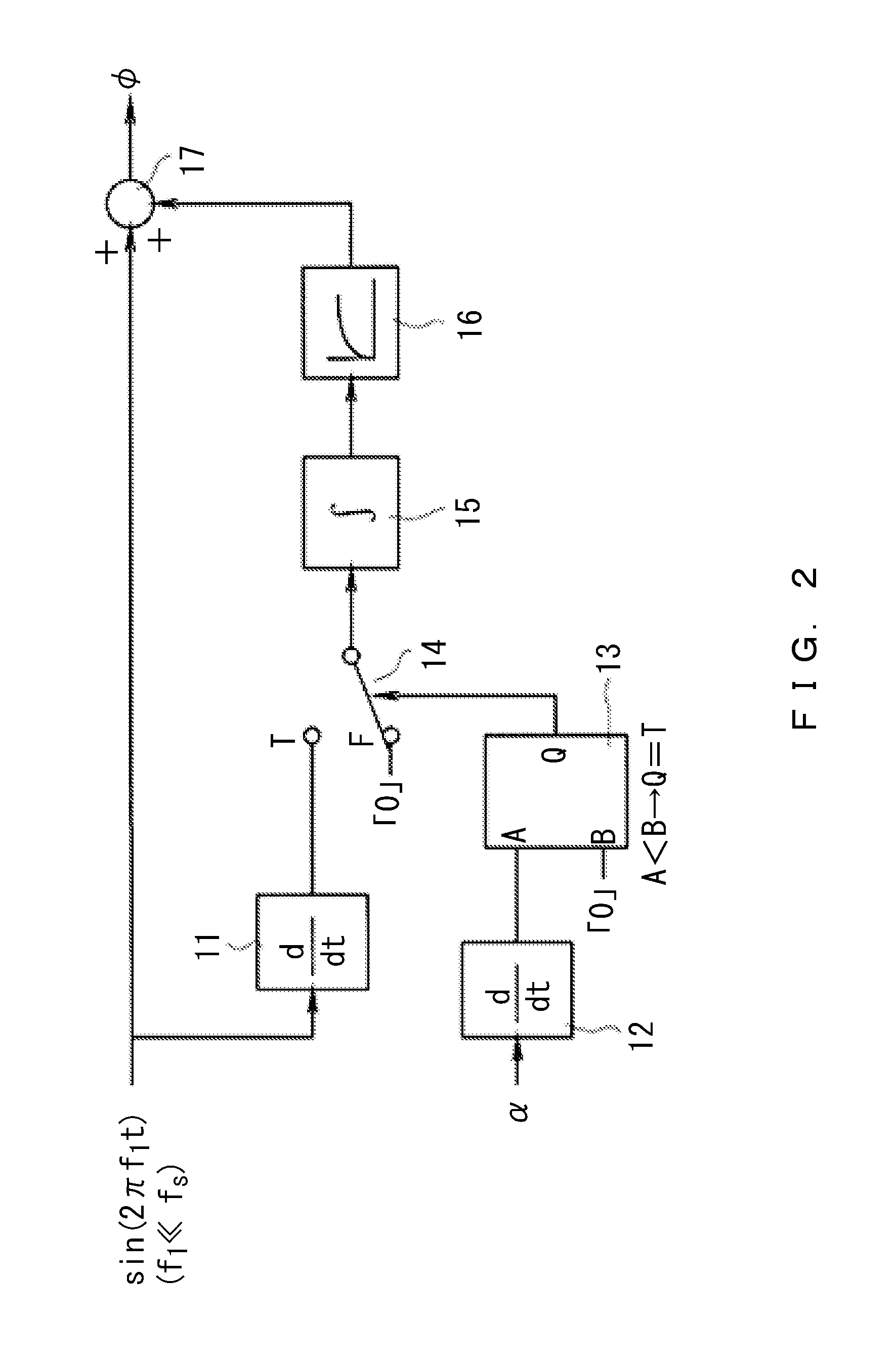Power supply device
a power supply and power technology, applied in the direction of power conversion systems, energy saving, climate sustainability, etc., can solve the problems of large circuit size, reduced power supply efficiency, and large switching loss of semiconductor switches, so as to reduce the size and cost of the entire device, and improve the input power factor of the power receiving circuit.
- Summary
- Abstract
- Description
- Claims
- Application Information
AI Technical Summary
Benefits of technology
Problems solved by technology
Method used
Image
Examples
first embodiment
[0093]Described below is a first embodiment on the basis of FIG. 2 and FIG. 3.
[0094]First, in the control block illustrated in FIG. 2, a sine wave input signal sin(2πf1t) for one cycle is provided. A frequency f1 of the sine wave input signal is set to be a sufficiently smaller value than a power source frequency fs, such as about 1 / 10 of fs. When an output of the control block is a compensation period φ from a zero crossing point ZCP of a current i in FIG. 3 (corresponding to a compensation period β in the second prior application invention described above), the period φ is changed with the same frequency f1 as that of the input signal sin(2πf1t). When this happens, as the input signal is changed, a time period α in FIG. 3 is also changed. When the input power factor of the power receiving circuit 320 is low, α becomes long, and when the input power factor is high, α becomes short. A reason for that is described below.
[0095]First, during a time period ii that corresponds to the tim...
second embodiment
[0106]Described next is a second embodiment that corresponds to claim 2.
[0107]FIG. 4 illustrates operating waveforms of a current i that flows through the power receiving coil 120, an induced voltage vin of the power receiving coil 120, a voltage v between AC terminals of a bridge circuit, and a fundamental wave component v′ of the voltage v between the AC terminals of the bridge circuit, and driving signals of switches Qu, Qx, Qv, and Qy, in a case in which the second embodiment is applied to the non-contact power supply circuit illustrated in FIG. 1.
[0108]Details of a route of the current i are omitted, but during time periods forming a time period α (time periods during which the voltage visa zero voltage) I, III, IV, and VI in FIG. 4, the current i flows with a route passing through a power receiving coil 120, a resonance capacitor Cr, and any of the switches Qu, Qx, Qv, and Qy and diodes Du, Dx, Dv, and Dy. During the time periods I, III, IV, and VI, energy is stored in the pow...
third embodiment
[0111]Described next is a third embodiment that corresponds to claim 3.
[0112]FIG. 5 illustrates operating waveforms of a current i that flows through the power receiving coil 120, an induced voltage vin of the power receiving coil 120, a voltage v between AC terminals of a bridge circuit, and a fundamental wave component v′ of the voltage v between the AC terminals of the bridge circuit, and driving signals of switches Qu, Qx, Qv, and Qy, in a case in which the third embodiment is applied to the non-contact power supply circuit illustrated in FIG. 1.
[0113]Details of a route of the current i are omitted, but during time periods forming a time period α (time periods during which the voltage v is a zero voltage) (2) and (3) in FIG. 5, the current i flows with a route passing through a power receiving coil 120, a resonance capacitor Cr, and any of the switches Qu, Qx, Qv, and Qy and diodes Du, Dx, Dv, and Dy. During the time periods (2) and (3), energy is stored in the power receiving c...
PUM
 Login to View More
Login to View More Abstract
Description
Claims
Application Information
 Login to View More
Login to View More - R&D
- Intellectual Property
- Life Sciences
- Materials
- Tech Scout
- Unparalleled Data Quality
- Higher Quality Content
- 60% Fewer Hallucinations
Browse by: Latest US Patents, China's latest patents, Technical Efficacy Thesaurus, Application Domain, Technology Topic, Popular Technical Reports.
© 2025 PatSnap. All rights reserved.Legal|Privacy policy|Modern Slavery Act Transparency Statement|Sitemap|About US| Contact US: help@patsnap.com



